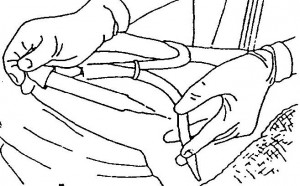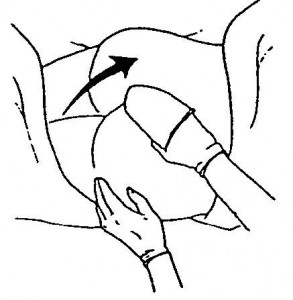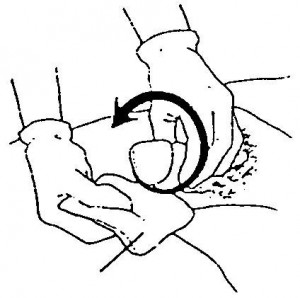a. General.
A sterile urine specimen can be obtained either by inserting a straight catheter into the urinary bladder and removing urine or by obtaining a specimen from the port of an indwelling catheter using sterile technique.
Urine from the dependent drainage bag should not be used for a specimen, since it is not fresh and would not reflect accurate test results.
Residual urine, urine left in the bladder after voiding, can be measured at the time of catheterization. The patient voids, and catheterization is performed within 10 minutes. If more than 60 ml of urine remains in the bladder, this is residual urine and the patient may need to have an indwelling catheter inserted.
The medical nurse must prepare the patient by explaining which type of urine specimen will be collected. It is important to relieve any anxiety by assuring the patient that there should be no discomfort during the procedure if the patient will remain relaxed: the patient should experience only mild pressure as the catheter is inserted and will feel nothing when urine is collected from the catheter port.
b. Important Points.
(1) Have all supplies ready for the patient to perform the procedure.
(2) Make certain the patient understands the proper procedure for collecting the urine specimen.
(3) Be certain the specimen is labeled correctly: patient’s name, room number, date, physician, and type of specimen.
c. Procedure.
(1) Read physician’s orders.
(2) Collect supplies.
(a) Sterile cotton balls.
(b) Antiseptic.
(c) Sterile specimen container.
(3) Introduce yourself to the patient.
(4) Identify patient by checking his identification band.
(5) Explain the procedure to the patient.
(6) Obtain the catheter port collection:
(a) Clamp tubing just below catheter port for about 30 minutes (figure 4-1).
(b) Return in 30 minutes and clean the port with alcohol prep.
(c) Insert needle into port at 30-degree angle, and withdraw 5 to 10 ml of urine for a specimen (figure 4-2).


(d) Place urine in sterile specimen cup.
(e) Unclasp catheter.
(f) Label specimen, and send to laboratory with requisition.
(g) Document the procedure.
(7) Obtain straight catheter collection.
(a) Wash your hands and don sterile gloves, and prepare supplies, using sterile technique–wrap the edges of the sterile drape around the gloved hands.
(b) Place sterile drape under patient’s buttocks (figure 4-3).

(c) Open the lubricant container; add antiseptic (usually iodine solution) to the cotton balls.
(d) Lubricate the catheter about 1.5 to 2 inches (3.5 to 5 cm).
d. Catheterize the Female Patient.
(1) To expose the meatus, place the thumb and forefinger of the nondominant hand between the labia minora. Spread and separate upward. Consider the gloved hand that has touched the patient to be contaminated (figure 4-4).

(2) Maintain the position of the contaminated hand until urine is flowing.
(3) Pick up the forceps and secure a cotton ball saturated with antiseptic solution–use one cotton ball for each stroke.
(4) Bring the cotton ball down the center over the meatus towards the rectum; next cleanse each lateral area from superior to inferior.
(5) Deposit used cotton balls onto plastic cover.
(6) To insert a catheter into a female with sterile gloves pick up catheter and insert through urinary meatus 2 to 3 inches (5 to 7.5 cm). DO NOT FORCE ENTRY OF THE CATHETER. Discontinue the treatment if the patient has unusual discomfort or if there is continual resistance to the insertion of the catheter. Report the information promptly.
(7) When urine flows, place end of catheter in specimen cup.
(8) Place lid on urine cup and label; clean up supplies.
(9) Send specimen to lab with requisition and document the procedure.
e. Catheterize the Male Patient.
(1) To cleanse the penis, swab the center of the meatus outward in a circular manner. Continue, using a new cotton ball for each progressively larger circle (figure 4-5).

(2) To insert a catheter into a male, apply gentle traction and pull the penis straight up; slightly pinch the end of the penis and insert the catheter 15 to 20 cm (6 to 8 inches). To facilitate the more difficult passage through the male urethra, ask the patient to breathe deeply; then rotate the catheter slightly. DO NOT FORCE ENTRY OF THE CATHETER. Discontinue the treatment if the patient has unusual discomfort or if there is continual resistance to the insertion of the catheter. Report the information promptly.
(3) When urine flows, place end of catheter in specimen cup.
(4) Place lid on urine cup and label. Clean up supplies, send specimen to lab with requisition, and document the procedure.
